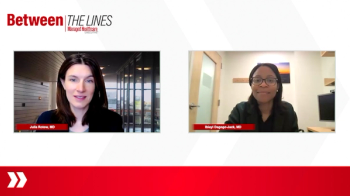
Drivers of Cost in ALS Care
Experts discuss the driving factors behind costs within the treatment landscape of ALS.
Episodes in this series

Laynie Dratch, ScM, CGC: Many factors make ALS [amyotrophic lateral sclerosis] an incredibly expensive disease and journey, both for the individual diagnosed and the family members around them. Doing things that might feel like routine parts of our days can require a lot of devices and human resources to accomplish the same tasks. For example, to get to a medical appointment, an individual might need a special van and someone to drive that van, to be able to take them in whatever wheelchair or assisted walking device they may have. The power wheelchair can be an extremely expensive. Not everybody ends up needing this device, but when it’s needed, it can be extremely costly. Individuals might have to make modifications to their home, whether that’s a renovation to get things they need on the first floor, like a bathroom or a bedroom. They might also need to install things like handrails or elevated toilet seats. Often these are done based on the advice of someone who can help—an occupational therapy [OT] or a physical therapy [PT]—thinking about what support an individual needs based on their symptoms and limitations.
There are also costs with things like needing a feeding tube placed or a ventilator if they elect to have 1. Those are all costs that a patient might incur. There are also the costs of the medical care itself: the routine follow-up visits required with the multidisciplinary team, whether that’s a neurologist, a pulmonologist, PT, OT, speech, nutrition, genetics, or a mental health therapist to help cope with some of the depression that they might be experiencing. These costs can add up both in terms of financial constraints and time. Also, individuals might need caregiving support. Some might have a care partner who’s able to handle most of their day-to-day needs, but in other situations they might need additional support, like a paid caregiver or caregivers. There are many costs that can be uncovered throughout this journey. It will be highly variable from individual to individual, but it’s an expensive disease.
We’re very excited about many of the therapies that are approved or gaining approval, but a lot of times these therapies are incredibly expensive. They might not be covered by insurance, and the out-of-pocket costs can be insurmountable for some families. Families may be forced to decide between whether they want to go bankrupt over a medication vs not take the medication at all. It’s an incredibly stressful component of care for some as well.
Jennifer Roggenbuck, MS, LGC: The factors that drive ALS costs are numerous, and individuals with ALS have a lot of medical and other needs that we try to address. That includes the cost of medications. We have some approved medications to treat the various aspects of ALS, which includes mobility assistance. In many cases, individuals with ALS need a wheelchair at some point; those machines are quite costly. We often work to develop communication devices, and that technology is also expensive. Some individuals with ALS need home health care or in-house therapy to maintain quality of life. All those things are quite expensive, and those are costs incurred by the patient. Family members often are impacted too because they have to take time off work or maybe even quit their jobs to care for their family member with ALS. The economic impacts are wide ranging. These costs are accumulate over the years because many individuals with ALS live 2 to 5 years, so these costs are ongoing during that time.
Transcript edited for clarity.
Newsletter
Get the latest industry news, event updates, and more from Managed healthcare Executive.





















































